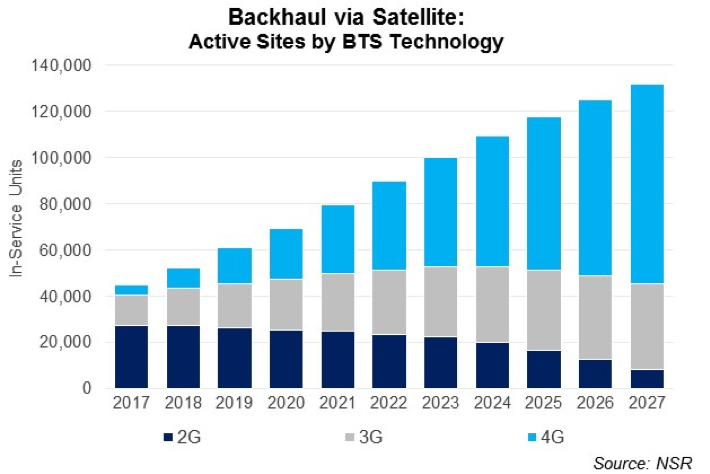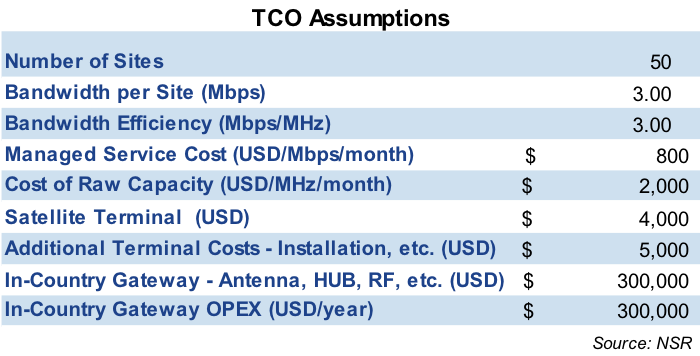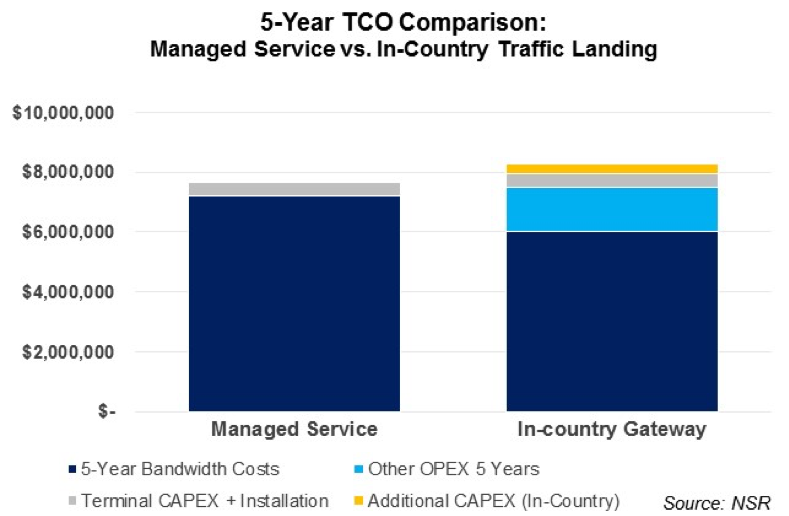|
Regulatory Barriers Limiting Cellular Backhaul
May 2nd, 2018 by Lluc Palerm-Serra, NSR
Satellite Backhaul has historically relied heavily on coverage
obligations to attract demand. Consequently, regulators were the
primary driver for demand in this vertical. However, if satcom
is to capture the massive opportunities in this vertical while
bridging the digital divide, it should be able to serve
commercially-driven sites. In this new paradigm, legacy
regulations and excessive protectionism is setting tremendous
barriers and, in many occasions, raising costs to uneconomical
levels.

Cellular Backhaul over satellite is a
key enabling tool for bridging the coverage gap that leaves 1
every 6 people outside any mobile coverage. According to NSR’S
Wireless Backhaul via Satellite, 12th
Edition report, satellite will serve over 130,000 mobile base
stations by 2027. Or put in another way, 100s of millions of
todays’ unconnected will rely on satcom to reach the Internet.
Regulators should acknowledge the potential of satellite to
bridge the digital divide and, consequently, create a favorable
environment to facilitate development of this market.
The Good Old Days
Satellite has been traditionally used by mobile operators to
serve the most remote sites to meet the coverage obligations set
by regulators during licensing or spectrum auction processes.
Most commonly, these are 2G sites consuming relatively small
amounts of bandwidth. Consequently, satellite capacity cost was
a controlled element from the mobile operator’s point of view as
other fronts such as construction and operations of the tower at
very remote locations contributed significantly to the Total
Cost of Ownership (TCO). In this scenario, Satellite Operators
were able to enjoy generous margins on the capacity sold as MNOs
had no other alternative, and the incentives for them to put
pressure on pricing was scarce. Regulators used to be the best
allies for the satcom industry as the level of demand was mostly
dictated by USO obligations.
However, internal pressures and technology evolution in the
satellite industry have led to drastic readjustments in price
levels. Regulatory-driven deployments are no longer enough to
sustain growth, and the industry needs to activate
commercially-driven projects to participate in the boom in
IP-related market growth. Now, satellite needs to be much more
price efficient, and regulations are many times a barrier for
market development.
Unfriendly Regulations for Satcom
Satellite has done a tremendous job in increasing its
competitiveness in this vertical with innovative technologies
both in space and on the ground. However, it still encounters
important barriers in multiple fronts. Some of the biggest
markets for Cellular Backhaul over satellite present very
stringent regulations. China is essentially a closed market,
India presents very rigid conditions for international actors,
and many other countries in regions such as Africa or Southeast
Asia have tough conditions like the requirement to land traffic
locally. Given the new HTS architectures, many times with
pre-defined gateway beams, this condition lures away the cost
benefits of the new generation of satellites.

Running a use case scenario with 50 sites and a bandwidth
consumption of 3 Mbps per site (industry standard for a 3G
network) and comparing a fully managed service (bandwidth fully
managed from the HTS gateway) with an In-country gateway (needs
to develop a local landing spot with HUB, antenna, network
management team, etc.), one easily finds the extra cost
generated when this kind of requirements are in place.
Furthermore, developing the capabilities to run this kind of
network, finding the talent, etc. are not easy tasks. Many of
the new HTS satellites are not even able to support this kind of
network as the entire traffic needs to pass through one of its
predefined gateways.


Not all Capacity is Equal
In view of these requirements and with an eye on this growing
vertical, some satellite operators are deploying HTS systems
that have greater flexibility to support in-country landing of
traffic. This is the case for Intelsat’s EPIC with its digital
payload supporting any beam to any beam communications. Others
like Avanti are designing and setting up In-Country gateways in
key markets like Nigeria.
In order to respond to these requirements, equipment vendors are
also adapting their offer with a range of low-CAPEX baseband
equipment. Some like UHP are even going one step further,
offering remote cloud-based network management systems for
in-country networks.
Bottom Line
The satellite industry has progressed in becoming a competitive
solution in the Cellular Backhaul ecosystem. However, there are
still multiple barriers somehow outside the control of the
industry, ranging from awareness, perception and the regulatory
ecosystem.
Regulators have long been allies driving demand for the satcom
industry in the form of USO requirements and coverage
obligations. However, in this new business environment in which
satellite wants to play a bigger role in commercially-driven
deployments, some aspects of the regulatory ecosystem are
dragging industry growth.
Some actors are adapting to the legal requirements to serve the
backhaul market gaining an advantage in the form of customized
capacity with traffic landing flexibility.
|








